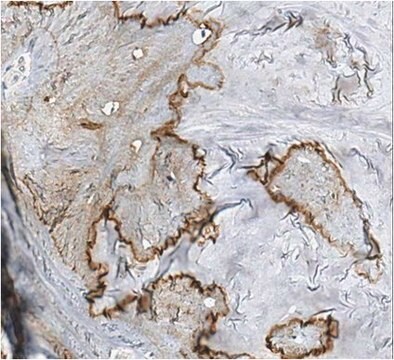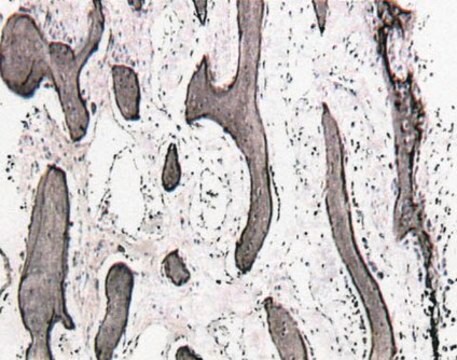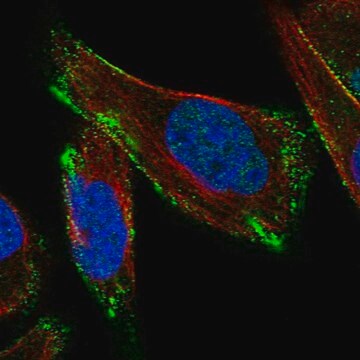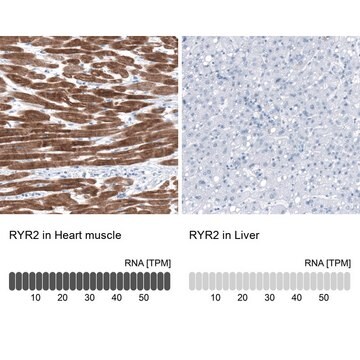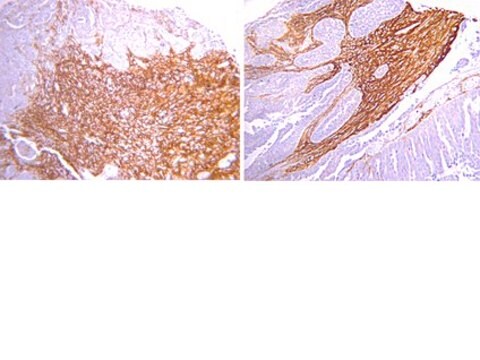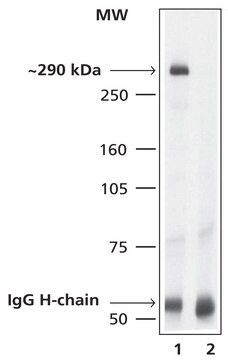AB1858
Anti-Osteonectin Antibody
serum, Chemicon®
Synonym(s):
SPARC
Sign Into View Organizational & Contract Pricing
All Photos(2)
About This Item
UNSPSC Code:
12352203
eCl@ss:
32160702
NACRES:
NA.41
clone:
polyclonal
application:
ELISA
IHC
IHC
species reactivity:
human
technique(s):
ELISA: suitable
immunohistochemistry: suitable (paraffin)
immunohistochemistry: suitable (paraffin)
citations:
8
Recommended Products
biological source
rabbit
Quality Level
antibody form
serum
antibody product type
primary antibodies
clone
polyclonal
species reactivity
human
manufacturer/tradename
Chemicon®
technique(s)
ELISA: suitable
immunohistochemistry: suitable (paraffin)
NCBI accession no.
UniProt accession no.
shipped in
wet ice
target post-translational modification
unmodified
Gene Information
human ... SPARC(6678)
General description
Osteonectin is one of the major noncollagenous proteins in the extracellular matrix of bone. It is a glycoprotein with a molecular weight of 43 kDa and has calcium-binding properties.
Specificity
Human Osteonectin (ON).
Immunogen
recombinant osteonectin expressed in human embryonal kidney line HEK-293.
Application
Anti-Osteonectin Antibody is an antibody against Osteonectin for use in ELISA, IH(P).
ELISA (1:5,000)
Immunohistochemistry on paraffin-embedded tissue sections (1:1,000)
Optimal working dilutions must be determined by the end user.
Immunohistochemistry on paraffin-embedded tissue sections (1:1,000)
Optimal working dilutions must be determined by the end user.
Research Category
Cell Structure
Cell Structure
Research Sub Category
Osteobiology
Osteobiology
Physical form
Rabbit serum. Lyophilized. Reconstitute with 100 μL of sterile distillled water.
Storage and Stability
Maintain lyophilized material at -20°C for up to 12 months. After reconstitution maintain at -20°C in undiluted aliquots for up to 6 months. Avoid repeated freeze/thaw cycles.
Legal Information
CHEMICON is a registered trademark of Merck KGaA, Darmstadt, Germany
Disclaimer
Unless otherwise stated in our catalog or other company documentation accompanying the product(s), our products are intended for research use only and are not to be used for any other purpose, which includes but is not limited to, unauthorized commercial uses, in vitro diagnostic uses, ex vivo or in vivo therapeutic uses or any type of consumption or application to humans or animals.
Not finding the right product?
Try our Product Selector Tool.
Storage Class Code
11 - Combustible Solids
WGK
WGK 1
Flash Point(F)
Not applicable
Flash Point(C)
Not applicable
Certificates of Analysis (COA)
Search for Certificates of Analysis (COA) by entering the products Lot/Batch Number. Lot and Batch Numbers can be found on a product’s label following the words ‘Lot’ or ‘Batch’.
Already Own This Product?
Find documentation for the products that you have recently purchased in the Document Library.
Prognostic value of NDRG1 and SPARC protein expression in breast cancer patients.
Nagai MA, Gerhard R, Fregnani JH, Nonogaki S, Rierger RB, Netto MM, Soares FA.
Breast Cancer Research and Treatment null
SPARC osteonectin, an endogenous mechanism for targeting albumin to the blood-cerebrospinal fluid interface during brain development.
Liddelow SA, Dziegielewska KM, M?llg?rd K, Phoenix TN, Temple S, Vandeberg JL, Saunders NR
The European Journal of Neuroscience null
Shane A Liddelow et al.
PloS one, 9(9), e106592-e106592 (2014-09-12)
To maintain the precise internal milieu of the mammalian central nervous system, well-controlled transfer of molecules from periphery into brain is required. Recently the soluble and cell-surface albumin-binding glycoprotein SPARC (secreted protein acidic and rich in cysteine) has been implicated
The effects of tenascin C knockdown on trabecular meshwork outflow resistance.
Keller, KE; Vranka, JA; Haddadin, RI; Kang, MH; Oh, DJ; Rhee, DJ; Yang, YF; Sun et al.
Investigative Ophthalmology & Visual Science null
Shane A Liddelow et al.
PloS one, 7(3), e33554-e33554 (2012-03-30)
Exchange mechanisms across the blood-cerebrospinal fluid (CSF) barrier in the choroid plexuses within the cerebral ventricles control access of molecules to the central nervous system, especially in early development when the brain is poorly vascularised. However, little is known about
Our team of scientists has experience in all areas of research including Life Science, Material Science, Chemical Synthesis, Chromatography, Analytical and many others.
Contact Technical Service